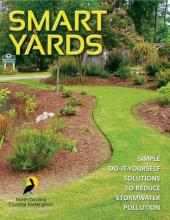
Stormwater pollution is the number one threat to coastal water quality in North Carolina, where it contributes to beach closures, impacts tourism, and interrupts shellfish harvests. Rapid urbanization, population growth, and a shifting climate have all converged to make it increasingly difficult for the state ’s communities to reduce the volume of stormwater washing over th landscape and protect water quality. Excess runoff also leads to street flooding that ranges from being a nuisance to a danger to public safety. A 2013 Collaborative Research project led by the North Carolina Reserve, the North Carolina Coastal Federation, and the University of North Carolina Wilmington collaborated with local communities, nonprofits, and state agencies to reduce the volume of polluted stormwater runoff in southeast coastal North Carolina.
This Smart Yard Guide includes simple projects that homeowners can undertake to reduce stormwater runoff from their yards. The goal of Smart Yards is to use the soil, plants, and containers to capture rain before it has a chance to become polluted runoff.